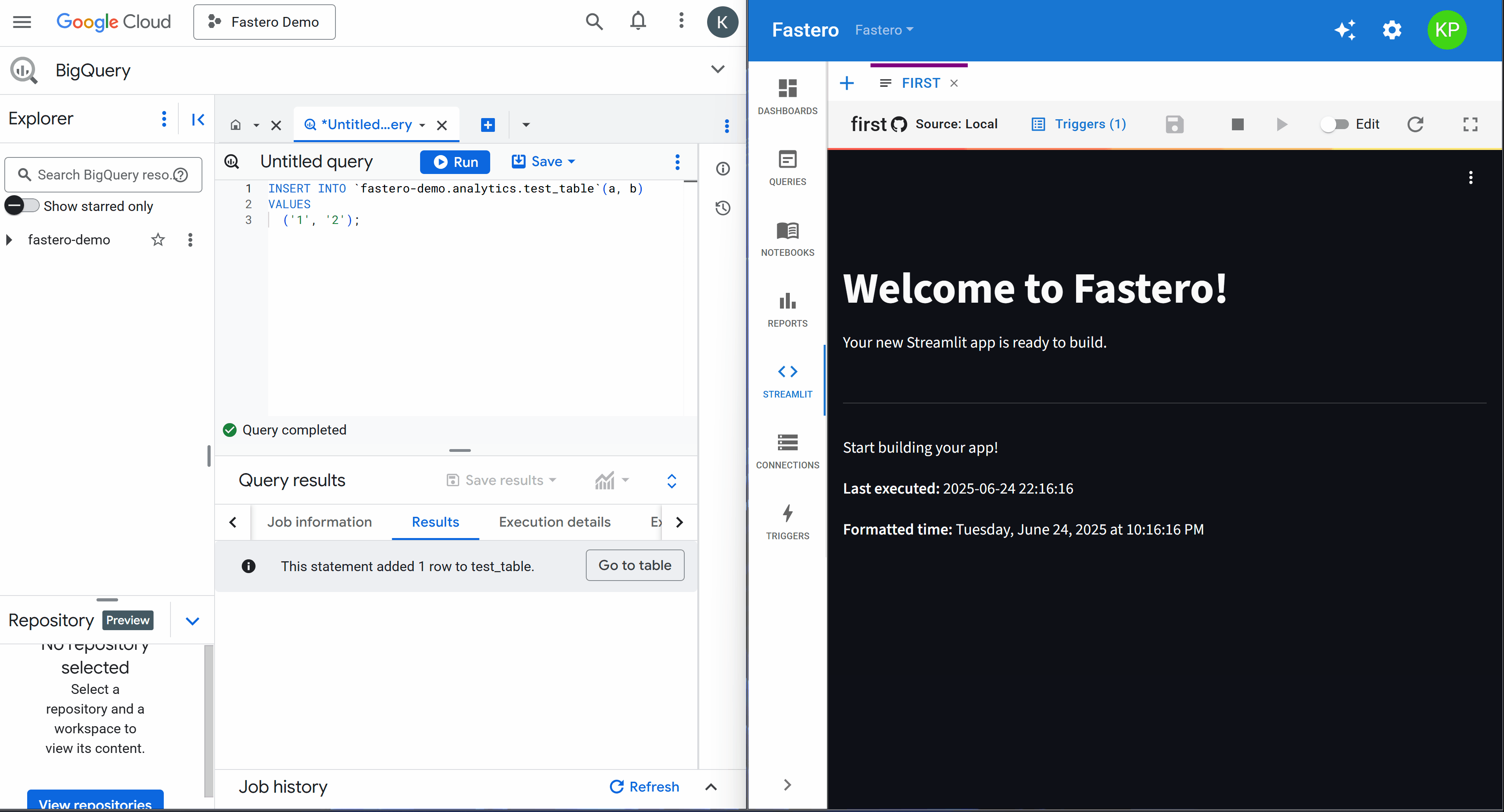Fastero vs Streamlit Cloud
The most direct comparison in Streamlit hosting. Streamlit Cloud offers simple GitHub‑based deployment for individual apps, while Fastero provides enterprise‑grade hosting with event‑driven updates, RBAC, and unified analytics workflows.

At a glance
Choose Fastero for:
- •Enterprise teams with org/project structure
- •Real‑time data‑driven app updates
- •Customer‑facing embedded analytics
- •API‑driven app lifecycle management
- •Integration with broader analytics platform
Choose Streamlit Cloud for:
- •Simple personal or team projects
- •GitHub‑first workflow and version control
- •Quick prototyping and demos
- •Free tier for public repositories
- •Minimal setup and configuration
Feature comparison
| Capability | Fastero | Streamlit Cloud | Snowflake Streamlit | Hex | Grafana |
|---|---|---|---|---|---|
| Hosted Streamlit | ✅ | ✅ | ✅ | ❌ | ❌ |
| Event‑driven auto‑reload | ✅ | ⚠️ | ⚠️ | ⚠️ | ⚠️ |
| Org/Project RBAC for apps | ✅ | ⚠️ | ✅ | ⚠️ | ⚠️ |
| File sync from DB (not just Git) | ✅ | ❌ | ❌ | ⚠️ | ❌ |
| Unified proxy (WS + embed‑friendly) | ✅ | ⚠️ | ✅ | ✅ | ✅ |
| Unified trigger system | ✅ | ❌ | ⚠️ | ✅ | ✅ |
| NL→SQL + notebooks together | ✅ | ❌ | ⚠️ | ✅ | ❌ |
* Competitor capabilities based on public documentation as of January 2025. Features may vary significantly by plan, configuration, and implementation.
We strive for accuracy but recommend verifying current capabilities directly with each vendor as features evolve rapidly.
Deployment workflow comparison
Fastero: Event‑driven deployment
Streamlit Cloud: Git‑based deployment
Team collaboration differences
Fastero collaboration
- • Org‑level team management with roles
- • Project‑based app organization
- • Shared database connections and secrets
- • API access for programmatic management
- • Centralized billing and usage tracking
Streamlit Cloud collaboration
- • GitHub repository‑based permissions
- • Individual app management
- • Personal secrets management
- • Community sharing features
- • Free tier for public apps
When to choose each platform
Fastero is better for:
- • Enterprise deployments: Customer‑facing analytics with SSO/RBAC
- • Real‑time applications: Apps that must update immediately when data changes
- • Integrated workflows: Apps that connect to broader analytics pipelines
- • Multi‑database scenarios: Joining data across PostgreSQL, BigQuery, Snowflake
- • API‑first architecture: Programmatic app lifecycle management
Streamlit Cloud is better for:
- • Simple prototypes: Quick demos and proof‑of‑concepts
- • Individual projects: Personal data science portfolios
- • GitHub‑centric teams: Workflows already built around Git
- • Cost‑sensitive projects: Free tier for public applications
- • Minimal complexity: No infrastructure or enterprise features needed
Migration paths
From Streamlit Cloud to Fastero: Export your GitHub repository code and import into Fastero's editor. Configure database connections and set up event triggers for real‑time updates. Most Streamlit code migrates directly with minimal changes.
From Fastero to Streamlit Cloud: Export app code and create a GitHub repository. Replace Fastero‑specific database connections with standard Streamlit connection patterns. Remove trigger‑specific logic and convert to manual refresh patterns.
Hybrid approach: Use Streamlit Cloud for prototypes and demos, promote to Fastero for production enterprise deployments. This gives you the best of both worlds.
Related articles
Try both platforms
Start with Streamlit Cloud for simple projects, upgrade to Fastero when you need enterprise features, real‑time updates, or multi‑database integration. Both have free tiers to get started.